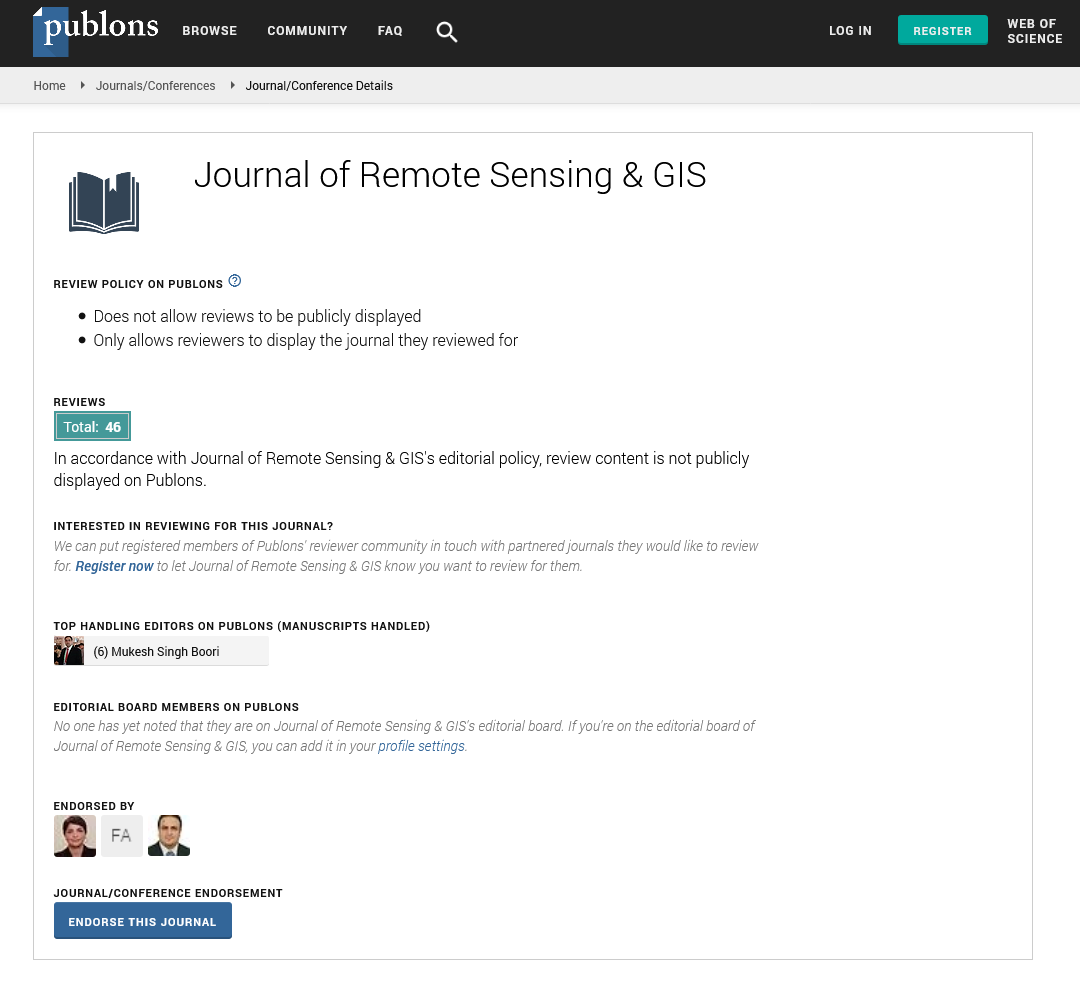Indexed In
- Open J Gate
- RefSeek
- Hamdard University
- EBSCO A-Z
- OCLC- WorldCat
- Publons
- International Scientific Indexing
- Euro Pub
- Google Scholar
Useful Links
Share This Page
Journal Flyer

Open Access Journals
- Agri and Aquaculture
- Biochemistry
- Bioinformatics & Systems Biology
- Business & Management
- Chemistry
- Clinical Sciences
- Engineering
- Food & Nutrition
- General Science
- Genetics & Molecular Biology
- Immunology & Microbiology
- Medical Sciences
- Neuroscience & Psychology
- Nursing & Health Care
- Pharmaceutical Sciences
Opinion Article - (2024) Volume 13, Issue 3
Monitoring Coastal Erosion with Remote Sensing and GIS: Challenges and Solutions
Zhao Liu*Received: 26-Aug-2024, Manuscript No. JGRS-24-26973; Editor assigned: 29-Aug-2024, Pre QC No. JGRS-24-26973 (PQ); Reviewed: 13-Sep-2024, QC No. JGRS-24-26973; Revised: 20-Sep-2024, Manuscript No. JGRS-24-26973 (R); Published: 27-Sep-2024, DOI: 10.35248/2469-4134.24.13.355
Description
Coastal erosion is a significant environmental concern affecting ecosystems, infrastructure and human settlements. The continuous loss of coastal lands poses severe threats to biodiversity, economies and livelihoods. Remote sensing and Geographic Information System (GIS) technologies offer valuable tools to monitor and manage coastal erosion effectively. Coastal zones, where land meets the ocean, are dynamic environments subject to natural processes like erosion, accretion and sedimentation. Human activities such as construction, land reclamation and climate change-induced sea level rise exacerbate coastal erosion. The ability to monitor and assess these changes is important to developing sustainable management strategies. Traditionally, field surveys and in-situ measurements have been used to monitor coastal dynamics, but these methods are labor-intensive and spatially limited.
Remote sensing and GIS have emerged as efficient alternatives, enabling continuous, large-scale monitoring of coastal erosion. These technologies provide temporal and spatial insights into shoreline changes, allowing decision-makers to respond more effectively. Despite their potential, significant challenges remain, particularly in terms of data quality, accuracy and the need for improved algorithms. This manuscript highlights these challenges and proposes solutions to optimize the use of remote sensing and GIS for coastal erosion monitoring.
Remote sensing in coastal erosion monitoring
Remote sensing involves the acquisition of information about an object or area without direct contact, typically through satellite or airborne sensors. For coastal erosion monitoring, remote sensing provides important data on shoreline position, wave dynamics, sediment transport and land cover changes. Various types of remote sensing technologies are applicable to coastal monitoring:
Optical sensors: These provide high-resolution imagery in visible and near-infrared bands, useful for detecting changes in land cover and shoreline delineation.
Synthetic Aperture Radar (SAR): SAR operates in the microwave spectrum and is particularly useful for coastal monitoring under cloud cover or at night. It can provide detailed surface characteristics, including topography and land deformation.
LiDAR (Light Detection and Ranging): LiDAR provides accurate elevation data and is invaluable for measuring changes in coastal topography and sediment dynamics.
Multispectral and hyperspectral sensors: These sensors capture data in multiple wavelengths and can differentiate between various types of land cover, sediment composition and vegetation health in coastal areas.
Applications in coastal erosion
Remote sensing technologies allow for:
Shoreline mapping: Optical and SAR images can detect shoreline changes over time, enabling the measurement of erosion rates.
Sediment transport monitoring: Multispectral and SAR images help track sediment movement, which is important for understanding erosion and deposition processes.
Topographic changes: LiDAR data can assess changes in coastal topography, providing a 3D representation of eroding shorelines and vulnerable areas.
GIS in coastal erosion monitoring
Geographic Information Systems (GIS) are used to manage, analyze and visualize spatial data related to coastal erosion. GIS integrates data from multiple sources, including remote sensing, field surveys and historical records, to create comprehensive models of coastal change. One of GIS's primary strengths is its ability to integrate various types of spatial and non-spatial data. For coastal erosion monitoring, GIS can combine:
Remote sensing imagery: Optical, radar and LiDAR data to provide continuous monitoring.
Historical shoreline data: From past records to analyze long-term erosion trends.
Hydrodynamic models: Predictive models that simulate wave action, storm surges and sea level rise.
Socio-economic data: Population density, infrastructure vulnerability and land use patterns to assess the impact of erosion on communities.
Spatial analysis
GIS tools allow for complex spatial analysis, including:
Change detection: By comparing past and current datasets, GIS can detect the rate and extent of coastal erosion.
Erosion susceptibility mapping: By integrating various environmental and anthropogenic factors, GIS can generate maps highlighting areas at higher risk of erosion.
Predictive modeling: GIS supports the development of predictive models to forecast future erosion based on sea level rise scenarios and climate change projections.
Conclusion
Remote sensing and GIS are powerful tools for monitoring coastal erosion, providing data to guide mitigation and adaptation strategies. However, challenges such as data resolution, accuracy, accessibility and integration must be addressed to fully realize their potential. By using technological advancements, promoting data sharing and engaging local communities, it is possible to develop more effective and sustainable solutions for managing coastal erosion.
Citation: Liu Z (2024). Monitoring Coastal Erosion with Remote Sensing and GIS: Challenges and Solutions. J Remote Sens GIS. 13:355.
Copyright: © 2024 Liu Z. This is an open-access article distributed under the terms of the Creative Commons Attribution License, which permits unrestricted use, distribution and reproduction in any medium, provided the original author and source are credited.

